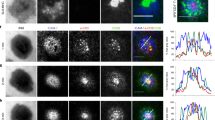Abstract
THE lymphocyte function-associated molecule LFA-1 (CD 11 a/ CD 18) plays a key part in lymphocyte adhesion1,2. Lymphocytes do not adhere spontaneously; activation of protein kinase C (PKC)3 by phorbol esters, however, gives rise to strong LFA-1-dependent adhesion4, indicating that activation of LFA-1 is required to induce cell adhesion. We have now investigated whether the functionally important CD2 and CD3 surface structures on T lymphocytes5–8 are involved in the activation of LFA-1. The stimulation of these molecules, which causes activation of PKC9,10, strongly promoted LFA-1-dependent adhesion. Furthermore, we demonstrate by using cells from an LFA-1-deficient patient that this enhanced lymphocyte adhesion is caused by activation of the LFA-1 molecule and not by activation of its ligands. LFA-1 was persistently activated by triggering through CD2 but only transiently by triggering through CD3. We postulate that CD2 and CD3 can differentially regulate the affinity of LFA-1 for its ligands by modulating its molecular conformation through PKC-dependent mechanisms.
This is a preview of subscription content, access via your institution
Access options
Subscribe to this journal
Receive 51 print issues and online access
$199.00 per year
only $3.90 per issue
Buy this article
- Purchase on Springer Link
- Instant access to full article PDF
Prices may be subject to local taxes which are calculated during checkout
Similar content being viewed by others
References
Springer, T. A., Dustin, M. L., Kishimoto, T. K. & Marlin, S. D. A. Rev. Immun. 5, 223–252 (1987).
Martz, E. Hum. Immun. 18, 3–37 (1987).
Nishizuka, Y. Nature 308, 693–697 (1984).
Patarroyo, M. P. G., Beatty, P. G., Fabre, W. & Gahmberg, C. G. Scand. J. Immun. 22, 171–182 (1985).
Reinherz, E. L., Meuer, S. C. & Schlossman, S. F. Immunol. Rev. 74, 83–112 (1983).
Shaw, S. et al. Nature 323, 262–264 (1986).
Meuer, S. C. et al. Cell 36, 897–906 (1984).
Breitmeyer, J. B., Daley, J. F., Levine, H. B. & Schlossman, S. F. J. Immun. 139, 2899–2905 (1987).
Imboden, J. B. & Stobo, J. D. J. exp. Med. 161, 446–456 (1985).
Pantaleo, G. et al. Eur. J. Immun. 17, 55–60 (1987).
Marlin, S. D. & Springer, T. A. Cell 51, 813–819 (1987).
Staunton, P. E. et al. Nature 339, 61–64 (1989).
Philips, M. R., Buyon, J. P., Winchester, R., Weissman, G. & Abramson, S. B. J. clin. Invest. 82, 495–501 (1988).
Wright, S. D. & Meyer, B. C. J. Immun. 136, 1759–1764 (1986).
Keizer, G. D., Visser, W., Vliem, M. & Figdor, C. G. J. Immun. 140, 1393–1400 (1988).
Keizer, G. D. thesis Univ. Amsterdam (1987).
Van Lier, R. A. W., Brouwer, M. & Aarden, L. A. Eur. J. Immun. 18, 167–172 (1988).
Miedema, F. et al. J. Immun. 134, 3075–3081 (1985).
Van Noesel, C. et al. Nature 333, 850–852 (1988).
Spits, H. et al. Science 232, 403–405 (1986).
Hara, T. & Fu, S. M. in Leucocyte Typing II Vol. 3 (ed. Reinherz, E.) 77–84 (Springer Verlag, New York, 1986).
Chatila, T. A. & Geha, R. S. J. Immun. 140, 4308–4314 (1988).
Burn, P., Kupfer, A. & Singer, S. J. Proc. natn. Acad. Sci U.S.A. 85, 497–501 (1988).
Cantrell, D. A., Verbi, W., Davies, A., Parker, P. & Crumpton, M. J. Eur. J. Immun. 18, 1391–1396 (1988).
Spits, H. et al. Hybridoma 4, 423–437 (1983).
Rotteveel, F. T. M., Braakman, E., Robbe, B. & Lucas, C. J. Cell. Immun. 111, 473–481 (1988).
Van de Rijn, m. et al. Cytogenet. Cell Genet. 36, 525–531 (1983).
Borst, J. et al. Hum. Immun. 17, 426–442 (1986).
Author information
Authors and Affiliations
Rights and permissions
About this article
Cite this article
van Kooyk, Y., van de Wiel-van Kemenade, P., Weder, P. et al. Enhancement of LFA-1-mediated cell adhesion by triggering through CD2 or CD3 on T lymphocytes. Nature 342, 811–813 (1989). https://doi.org/10.1038/342811a0
Received:
Accepted:
Issue Date:
DOI: https://doi.org/10.1038/342811a0
This article is cited by
-
Perspectives of tumor-infiltrating lymphocyte treatment in solid tumors
BMC Medicine (2021)
-
Alpha-mangostin dephosphorylates ERM to induce adhesion and decrease surface stiffness in KG-1 cells
Human Cell (2021)
-
T-lymphocyte homing: an underappreciated yet critical hurdle for successful cancer immunotherapy
Laboratory Investigation (2017)
-
Human mesenchymal stem cells target adhesion molecules and receptors involved in T cell extravasation
Stem Cell Research & Therapy (2015)
-
Beta2-integrin activation on T cell subsets is an independent prognostic factor in unstable angina pectoris
Basic Research in Cardiology (2009)
Comments
By submitting a comment you agree to abide by our Terms and Community Guidelines. If you find something abusive or that does not comply with our terms or guidelines please flag it as inappropriate.



